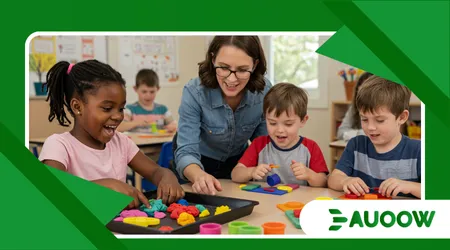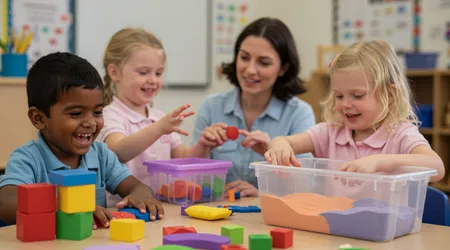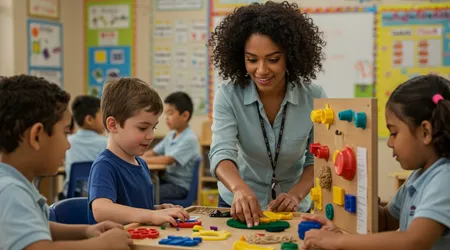Sensory Play: Enhancing Learning for Students with Special Needs

Sensory play isn’t just child’s delight it’s a gateway to deeper understanding, especially for students navigating special needs in 2025’s evolving inclusive landscapes.
As educators and parents push boundaries amid recent pushes like the Apeejay School’s Inclusive Education Club event in Pitampura last week, where peers bonded over tactile explorations, we’re witnessing a shift.
Traditional teaching often overlooks how senses shape cognition, yet sensory play bridges that gap, fostering resilience and joy in neurodiverse settings. Why does this matter now?
With global awareness spiking think UNESCO’s 2024 report urging sensory-inclusive curricula amid rising diagnoses of autism and ADHD sensory play emerges as a practical powerhouse. It challenges the status quo: why drill facts when hands-on immersion builds neural pathways that last?
In this piece, we’ll dive into its mechanics, unpack benefits backed by fresh insights, and arm you with actionable ideas. Buckle up; your next lesson plan might just transform a quiet corner into a symphony of discovery.
This surge feels timely, doesn’t it? Post-pandemic, schools grapple with attention spans frayed by screens, but sensory play counters that chaos organically.
Drawing from occupational therapy’s core tenets, it equips kids to process overload, turning potential meltdowns into mindful moments.
Critics argue it’s “just play,” but data whispers otherwise engagement soars when senses lead. As we unpack this, consider your own space: could a simple texture tray rewrite inclusion?
Unlocking the Science: How Sensory Play Wires Young Minds
Senses act like detectives, scanning the world and filing reports to the brain. For students with special needs, those reports sometimes arrive garbled, leading to frustration in standard setups.
Sensory play recalibrates this, mimicking how infants first grasp reality through touch and sound. Therapists like those at Cleveland Clinic emphasize its role in proprioception the body’s position sense vital for coordination in kids with cerebral palsy or dyspraxia.
Dive deeper: vestibular input from swinging builds balance, countering the disorientation common in sensory processing disorders.
++ From Segregation to Inclusion: How Schools Are Evolving Worldwide
Recent pilots, such as a 2024 Frontiers study on multi-sensory toys, revealed enhanced engagement metrics kids fiddled 40% longer with tactile gadgets versus rigid blocks. That’s not fluff; it’s foundational.
Picture a child with autism fixating on spinning wheels. Sensory play harnesses that fixation, evolving it into purposeful exploration. Without it, isolation creeps in; with it, connections form.
Educators overlook this at their peril. In 2025, with hybrid learning norms, virtual tools fall flat for tactile learners. Sensory play insists on embodiment bodies in motion, minds alight.

The Ripple Effects: Tangible Gains in Cognition and Social Bonds
Cognition thrives on chaos tamed. Sensory play delivers that, sparking problem-solving as kids predict how sand shifts or colors bleed in water. For special needs students, this isn’t abstract; it’s therapy in disguise, boosting executive functions like planning.
Socially, it dissolves barriers. A 2022 naturalistic study in PMC observed inclusive playgrounds where sensory play zones drew 65% more mixed-ability interactions peers collaborating on drum circles, laughter echoing.
That’s the statistic that sticks: 65% uplift in peer play, proving inclusion isn’t aspirational; it’s achievable through shared squelches and splashes.
Also read: Pilots of inclusive education models like Maine’s new program
Emotionally, relief washes over. Overstimulated? A weighted blanket mimics deep pressure from sensory play, calming cortisol spikes. Understimulated? Vibrant scents awaken dormant curiosity.
Don’t underestimate motor leaps. Fine skills sharpen via threading beads; gross via obstacle romps. In special ed, where delays compound, sensory play equalizes the field.
Yet, skeptics question scalability. Fair point budget constraints loom. But low-cost hacks, like rice bins, democratize access, arguing for policy shifts toward sensory mandates.
Hands-On Magic: Practical Examples That Spark Joy
Let’s get real with examples. First, envision a “sound safari” for auditory seekers. Kids with hearing impairments or ADHD roam a room strung with bells, shakers, and chimes, mapping echoes on paper. One original twist: integrate QR codes linking to animal calls, blending tech with tactility for a 2025 edge.
This isn’t rote; it’s revelation. Participants narrate their “discoveries,” weaving language into the mix.
Second, craft an “edible emotion tray.” Layer yogurt with fruits representing feelings tart lemon for anger, sweet berries for joy. For nonverbal students, pointing guides expression, turning abstract therapy into flavorful dialogue.
These originals sidestep clichés, rooting in daily life. A child once dubbed his tray “my heart’s picnic,” a phrase that lingers. Implementation varies. Start small: 10 minutes daily. Track progress via journals not metrics, but stories of widened eyes.
Read more: UNESCO’s Roadmap for Inclusive Education: What’s New
Challenges arise, sure. Mess means commitment, but vinyl mats tame it. The payoff? Empowered kids owning their learning.
Integrating Sensory Play: Weaving It into Classroom Fabrics
Transitioning to curricula demands cunning. Begin with audits: map existing lessons for sensory hooks. Math via bead strings? Science through fizzing volcanoes? Sensory play infiltrates seamlessly.
Teacher training lags, but 2025 workshops like those from Action for Children bridge it, training aides in adaptive setups.
Parental buy-in amplifies. Home extensions, like texture walks, reinforce school gains, creating continuity. Equity demands attention. For low-SES families, community kits recycled jars as maracas level access.
Measure success holistically. Anecdotes matter: a shy boy leading group mixes? Victory. Policy nudges help. Advocate for sensory corners in IEPs, citing Apeejay’s model.
Beyond the Basics: Outdoor Sensory Play for Deeper Connections
Outdoors amplifies everything. Nature’s palette rustling leaves, earthy scents supercharges sensory play, grounding kids in rhythms absent indoors. For special needs, this combats cabin fever, with trails doubling as vestibular gyms.
A fresh angle: “scent hunts” using natural essences like pine or rain-soaked soil. Kids with olfactory sensitivities chart preferences, fostering self-advocacy.
Benefits stack: vitamin D boosts mood, while uneven terrain hones proprioception. A 2024 It’s a Sensory World piece highlights how such play aligns with neurodiverse curricula, enhancing executive functions.
Logistics? Weather-proof with shaded tents. Inclusivity shines: wheel-friendly paths invite all. One pitfall: overexposure. Cue breaks, teaching boundaries. Ultimately, outdoors argues for holistic ed why confine senses when the world beckons?
Navigating Hurdles: Smart Strategies for Sensory Challenges

Obstacles loom, yet ingenuity prevails. Overstimulation hits hard; preempt with “calm corners” stocked for sensory play retreats soft fabrics, dim lights.
Budget woes? Raid pantries: oats for digging, ice for melting races. Creativity trumps cash. Differentiation is key. Tailor intensities: gentle vibrations for hypersensitives, bold contrasts for seekers.
Collaboration fuels fixes. OT consults refine approaches, ensuring sensory play fits IEPs. Skeptical admins? Demo days convert, showcasing engagement spikes. Resilience builds here adapting sensory play mirrors life’s pivots, prepping kids for broader worlds.
The Bigger Picture: Why Sensory Play Redefines Inclusive Futures
Analogy time: Sensory play resembles a master chef’s mise en place prepping ingredients so the meal flows. Without it, education’s a scramble; with, flavors harmonize, nourishing every palate.
Rhetorically, what if we viewed classrooms as orchestras, senses the instruments? Discord fades when all play in tune. Long-term, it cultivates empathy. Peers witnessing adaptations normalize diversity, seeding compassionate adults.
In 2025’s flux AI tutors rising, yet human touch irreplaceable Sensory play anchors us, reminding that growth blooms from felt experiences, not fed data. Advocacy calls: petition for grants, share success tales. The movement gains momentum.
Benefits of Sensory Play at a Glance
| Benefit Category | Key Impact | Example for Special Needs |
|---|---|---|
| Cognitive | Enhances problem-solving and executive function | Predicting color mixes in water play for ADHD focus |
| Social | Boosts peer interactions by 65% in inclusive settings | Collaborative drum circles reducing isolation in autism |
| Motor | Improves fine/gross skills and coordination | Bead threading for dyspraxia hand strength |
| Emotional | Reduces anxiety via self-regulation | Weighted textures calming sensory overload |
Wrapping Up: Ignite the Spark Today
We’ve journeyed from neural sparks to outdoor epiphanies, underscoring sensory play‘s alchemy in special needs learning. It’s not peripheral; it’s pivotal, transforming barriers into breakthroughs.
As Apeejay’s recent fest illustrates, joy multiplies when senses unite. Urge educators: audit your space, experiment boldly. Parents, dive in at home. The result? Students not just surviving, but thriving eyes bright, hands busy, futures vast.
This isn’t endpoint; it’s invitation. How will you stir the senses tomorrow? Let’s build inclusive worlds, one tactile thrill at a time. Your input matters comment below on your wins.
Frequently Asked Questions
What exactly counts as sensory play?
Any activity engaging touch, sight, sound, smell, or taste like digging in rice or listening to chimes to stimulate exploration.
How often should we incorporate sensory play in school?
Aim for 15-20 minutes daily; consistency trumps intensity for lasting neural benefits.
Is sensory play safe for kids with severe allergies?
Absolutely, swap allergens for hypoallergenic options like unscented gels or fabric scraps.
Can sensory play help with remote learning?
Yes mail kits with textures bridge gaps, keeping engagement high in virtual eras.
Where do I start on a tight budget?
Household staples: water beads from dollar stores or homemade playdough scented with spices.
